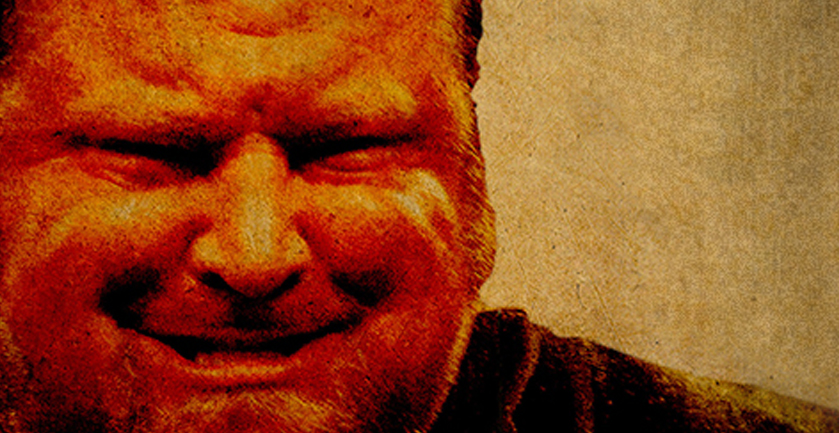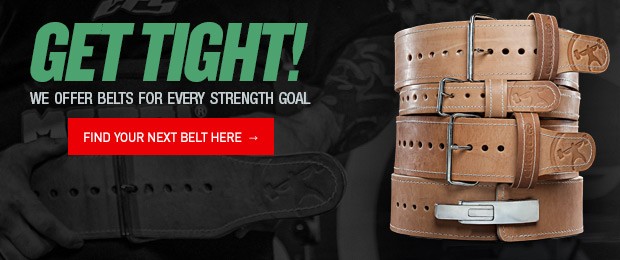
I see bracing as a key building block in the foundation of strength. I also see it as one of the most misunderstood and ill-performed aspects of strength. Bracing is not overly complicated in theory, but there is a lot to it. It is not incredibly hard to perform either, but it does take a lot of practice to get good at. It is one of those things you try at first that you may feel it helps but aren't sure how much. As you keep working on it and begin to master the technique you will fully understand the potential bracing has. You will see how important it is in your lifting. You will see how it helps you lift more weight while keeping your back healthy and safe.
RECENT: Putting It All Out There — Fighting Complacency and Contentment
Bracing of the core or midsection is actually natural to us, and it is something we do when we first learn to move. It advances through the time we crawl, stand, and walk. It is natural to us and it is actually how our midsection is designed. Somewhere down the line we forget this and end up using these core muscles only for movement or not much at all. The muscles of the pelvic floor—internal and external obliques, rectus abdominis, erector spinae, multifidus, transverse abdominis, and the diaphragm—are designed to give our midsection great bracing power. This, in turn, gives one of the weakest structural areas of the body great rigidity.
What does this mean to a lifter? It means achieving the best transfer of power throughout our entire bodies. It means no wasted or lost energy. It means much greater safety for our back. Basically, we will be able to lift a lot more. Of course this whole concept is much more complex in how it actually functions, but I will leave it to more scientific minds to explain in other articles. It makes sense and for the sake of this article I am more concerned with performing it correctly.
I will begin with some of the biggest mistakes I see lifters make when it comes to bracing. Taking a big breath into the lungs right before the lift is one that I see the most. This causes an open scissor effect between the pelvic floor and rib cage. It also makes it very difficult to get to your maximum amount of intra abdominal pressure (IAP) because you have expanded the lungs with air. Even if you do push your midsection out like you should, you will find there is not much IAP generated.
Wearing the weight belt too tight is also a big mistake I see people make. This does not allow for expansion of the midsection. Generally I will put a belt on someone where I can fit four fingers between the belt and their midsection. I will then have them brace, and if I cannot pull my fingers out then the belt is good. If I can pull them out, the belt needs to be tighter and they also need to work on their bracing. Sucking the abs in and trying to tighten them is another big mistake. This takes all the stability away from the core and is very unsafe. I have even seen lifters take in air and expand their midsection nicely, but instead of pushing out to brace they draw in to tighten their abs. Arching the low back too hard is also a mistake, because it again gives the open scissor effect. I see all these mistakes done far too often and in many different combinations.
Now that I have mentioned the most common mistakes, let's talk about why bracing is so important and what we are actually trying to achieve. As I said, the midsection is structurally the weakest part of our bodies. There is no rigid strong structure in it (such as bone) except the vertebra of the back. It is full of soft tissue, such as muscles and organs. Even the back itself is not all that ideal of a structure when it comes to being solid, because it is made to allow for great movement.
Between each small strong bone is a spongy soft nucleus in fluid (intervertebral disc). The structure is similar to a bunch of short cylinders with little rubber balls between them, attached together with small bungee cords. This design allows for great mobility in many directions but is very lacking in rigidity. Mother nature did not overlook this issue, though. When proper bracing is in effect, this very mobile but weak area becomes extremely stable and locked in. Our cranium to our pelvis becomes one solid cylinder and hinges at the hip joint. What was once very mobile is now solid as a rock and locked in place. This is what we are trying to achieve when we brace correctly — one solid cylinder from cranium to coccyx. This means no movement in the spine but instead only hinging at the hip joint.
Correct bracing starts with the stacking of the spine. This basically means the natural curve of the spinal column. There will be a small arch (lordosis) in the cervical spine and lumbar spine, along with a hunch (kyphosis) in the thoracic spine. The rib cage will also be pinned to the back of the spine rather than expanded up in a position of a big chest. This correct stacking of the spine is the strongest position for the spine. This stacked position also puts the body in the strongest possible position to brace, because it allows the rib cage to be brought down directly over the pelvic floor, meaning no open or closed scissor effect.
Once the spine is correctly stacked, air is sucked into the belly and filled up from the bottom of the belly to the top. If the air is going into the lungs and expanding the rib cage, you aren't bracing correctly. Remember that filling the belly full of air is not bracing — it is only one step. Next you have to expand all the muscles of the midsection while pushing them all out as far as possible. This does not mean just pushing the belly forward using the rectus abdominis; your whole midsection should be expanding, including your sides and back. It's just like blowing up a balloon. The bracing happens when you actively expand your entire midsection out in all directions, even the back. The last part of bracing is utilizing your latissimus dorsi muscles to help stabilize your whole spine. This is done by pulling down with your lats as if you're trying to compress your whole spine in that stacked position. Some people may not consider this part of bracing, but I do, because it is a major part of keeping the whole spine braced.
RELATED: Bracing and the Hip Hinge
Bracing is a very easy concept but usually takes a fair amount of work and practice to master. At first you may not see much effect or understand how important it is. Trust me, though — once you get it down you will be wondering why the hell you did not start doing it sooner. You will most likely start working on it and feel something, but not too much, because it will be a bit difficult to maintain bracing through a whole lift when you're just starting. As you keep working on it, there will be one time where things click and you get it. When it does, the weights will all of the sudden feel so much lighter and you will feel way more explosive. With continued dedication to it you will realize how much better your back feels—even after heavy squat and deadlift days—because you will be taking so much stress off it. You will also find you're getting a lot more out of your belt when you wear it. This is because you will be pushing out against it. If you currently do not get much more support or do not lift much more with your belt than without, your bracing needs work. Just like any technique, bracing takes practice to master.
There are a few tricks I use to help with learning the bracing process. First of these is to work on belly breathing. Breathing is not bracing but it will help with learning to expand the midsection. To help teach it I will also use a knee wrap, which I wrap around the lifter's midsection. I just go once around, not very tight but just snug. It helps with the proprioception when expanding the midsection. It basically gives the body something to push out against. I am not a huge fan of wearing the weight belt all the time, but when learning to brace it can be a handy tool. I will find where the lifter normally wears their belt and loosen it one to two holes. I do this so they have to learn to push out on the core more if they want to get any support out of the belt. Bracing is not just for the gym or when lifting heavy weights either. It will help in all aspects of life and can be practiced anywhere. I brace whenever I am picking something up, and practice it all the time. If I am watching television or driving home from work I practice bracing and work on breathing while braced. Bracing is natural to us but we have to retrain our bodies to make it habit again.
As I said, bracing itself is a pretty simple concept in theory and it makes sense. The muscles of the midsection are designed to brace the midsection of the body in this way. It is not too difficult to learn, but it will take lots of practice to master. If you want to lift heavier weights and do it in a much safer way then start working on your bracing today. It will not only help in the gym but in the rest of your life too. Your back will thank you for it (and the fact that it will give you PR lifts doesn’t hurt either).











Bracing, as is powerlifting, is completely knew to me. I think I do it allright already, that is when I do it at all. Way too often I forget about it and this makes "easy" lifts suddenly very difficult.
I will make bracing practice in my daily life a routine now.
Chad Aichs
Thank you and so glad you enjoyed it. Bracing is so important to keeping away injuries and t getting the most out of our bodies. I wish I could convince everyone to make it daily practice in their lives. Thanks so much for reading.
Chad Aichs
Thank you for your clear instruction and explanation. It has helped me a lot!!
You are more than welcome and I am very glad it helped. I hope it is helping you to hit some great pr lifts!
Get in my position first. IE making sure I am rooting, back in neutral, shoulder blades depressed with lats, rib cage pinned, etc. Then I take a breath followed by my brace. This then locks all those things and position in place. So I think it can work either way but I tend to breath then brace. Hope this answers your question.
Chad